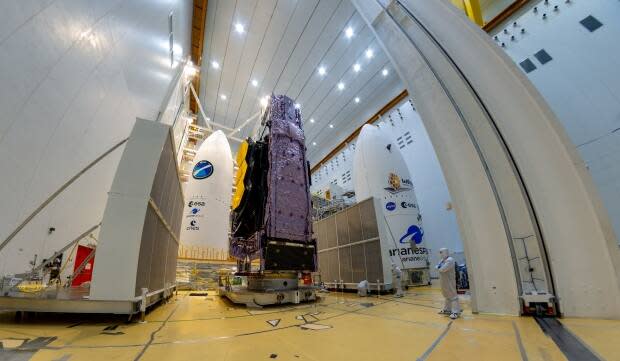Star search: Canadian scientist to travel way back in time using world's largest space telescope

A team of astrophysicists may soon be getting a key to unlocking the mystery on the origins of life.
The James Webb Space Telescope was launched into space from French Guiana in South America on Dec. 25.
With a price tag of $10 billion US, Webb is the largest and most powerful space telescope ever constructed by NASA, the National Aeronautics and Space Administration.
Canadian astrophysicist Tyrone Woods hopes to use it and find the first stars ever created by travelling through time — in a sense.
"We're going to be able to look back into this earliest epoch of the universe," Woods said.
Originally from Edmonton, Woods is currently a Plaskett Fellow at the National Research Council of Canada's Herzberg Astronomy and Astrophysics Research Centre in Victoria, B.C.

NASA touts Webb as the successor to the Hubble Space Telescope, which was launched in 1990. The new telescope is a collaboration between NASA, the European Space Agency and the Canadian Space Agency. The project has been decades in the making.
Since Webb has a much larger mirror than the Hubble, it can collect more light and peer farther back into time.
"Light has a fixed speed. It doesn't travel infinitely fast. It takes time," Woods said on CBC Edmonton's Radio Active.
While light travels at 300,000 kilometres per second, many stars are millions — if not billions — of light years away from Earth. It's possible that some of the stars we see in the night sky no longer exist.

Stars are born in areas of dust and gas known as stellar nurseries. To help find the first stars, Woods's team has built a cosmic roadmap by using computer simulations.
"So conventionally, we had always thought of the first stars as being so very compact and very blue," he said.
"We've seen that in some of them [nurseries of the very first stars], they would be the perfect conditions for making really massive, really bloated, really red stars."
Currently, the oldest known star is HD 140283, also known as the Methuselah Star. It is estimated to be 14 billion years old, similar in age to the universe.
Webb is primarily an infrared telescope, which means it sees light that our eyes cannot. It's possible that by focusing on infrared light, the telescope could find a planet similar to Earth, because infrared is a wavelength our own planet emits.
"We're going to be looking in the environment around some very big clusters of galaxies in order to find a magnified light from behind them and get a really, really deep exposure of the early universe," said Woods.
Other than the origin of the stars, Woods hopes the new telescope will also help scientists find the first black hole, how gases assemble in the universe, and more about how our own solar system was formed.
Webb will spend the next several months getting ready to look into the farthest reaches of the universe by unfolding its mirrors and massive sunshield and cooling down after travelling 1.5 million kilometres from Earth to its intended orbit around the sun.
"Over the subsequent year, we're going to start to see the first really exciting results," said Woods.

